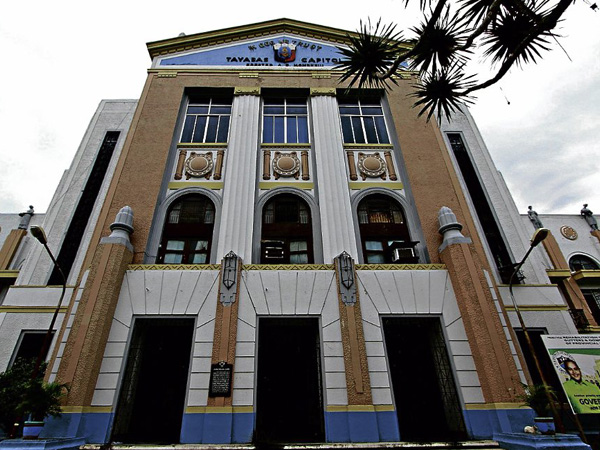Century-old ‘Kapitolyo’ undergoes rehabilitation

QUEZON residents are hoping that restoration work in the century-old provincial capitol in Lucena City will be completed soon. DELFIN T. MALLARI JR.
LUCENA CITY—Three times every day—at 7 a.m., 12 noon and 5 p.m.—a familiar siren blares from the century-old provincial capitol building in Lucena City, virtually serving as an alarm clock for residents.
“Every time I hear the siren at noontime, that’s the signal for me to go home and prepare lunch for my children who will return from school,” says Virginia Escobar, a home-service manicurist.
She, however, expresses concern that with the deteriorating state of the Kapitolyo, as the edifice is called, her reliable timer will soon be gone.
Nenita Guzman, 72, widow of a local war veteran, recalls that in the 1960s, when she was accompanying her husband in getting his pension check at the provincial post office on the ground floor of the building, the Kapitolyo was a beehive of activities. “There were always lots of people transacting with different offices and there were plenty of vendors, too,” she says.
“The capitol is now deserted like a ghost building,” she rues. Several years ago, most provincial offices left the capitol and moved to newly constructed buildings within the vicinity.
Article continues after this advertisementThe provincial government has decided to take steps to save the structure and “bring it back to its former glory” owing to its historical and cultural significance.
Article continues after this advertisement
Circa 1908
The building was constructed in 1908 on a piece of property donated by then Quezon Gov. Don Felimon Perez. American architect William Parsons and his consultant, Filipino architect Juan Arellano, worked on the neoclassical and art-deco design of the building.
Parsons arrived in the country in 1905 and was appointed chief architect of what was then the Philippine Bureau of Public Works. He was given general supervision over the design of all public buildings and parks throughout the country. On the other hand, Arellano, who designed the art-deco style of the Tayabas (former name of the province) capitol building, was noted for his famous works, such as the Manila Metropolitan Theater, Manila Post Office in Lawton and the Negros Occidental and Cebu provincial capitol buildings.
Each of its 24 statues lies on a pedestal with arris and fluting surrounding the top of the Kapitolyo. The statues were created by Italian sculptor Francesco Riccardo Monti, records from the provincial library show.
During the American colonial period, from 1930 to 1935, an additional floor was added. When World War II broke out, the structure was damaged but restoration work was made soon after the war.
Only a few provincial offices still occupy the first two floors of the concrete building which is marked by a “cross ventilation” design of long hallways and an opening on all sides with a grand staircase on the main lobby.
Historical landmark
The third floor still maintains its original spacious floor made from the finest hardwood, capped by a high ceiling. The place used to serve as ballrooms during the prewar and postwar periods. It still offers a grand view of the vast sunken Perez Park.
On March 10, 2010, the National Historical Institute (NHI), through Presidential Decree No. 260, declared the Quezon Kapitolyo a national historical landmark.
Shortly after the start of his administration in June 2010, Gov. David Suarez consulted the NHI on his building restoration plan. The NHI immediately conducted an inspection.
In its report on March 15, 2011, the NHI noted the “state of disorder” of the building, characterized by crowded spaces, deteriorating public corridors and hallways that “compromised” fire safety. Most of its former offices had been transformed into depositories of old government records and stockrooms.
Community support
It found that the “large windows that should be giving natural illumination to the building’s central space are blocked and the natural ventilation needed by the lobby and corridors is disregarded.” Some tiles used in previous repair works were “very foreign” to the original art-deco style, it said.
On July 16, 2011, Suarez issued Executive Order No. 16 which created a committee to take charge of the restoration project and ensure that it will conform with existing laws and policies involving historical sites. Conrado Escudero, a noted lover of history and owner of the plush Villa Escudero resort in Tiaong town, was designated chair.
“The restoration work will be true to the original design of the capitol building as much as possible,” Escudero had told the Inquirer in one of the committee meetings. He added that noted technical consultants involved in restoration works had already been tapped.
The provincial government will allocate funds as soon as the committee provides an estimate. Escudero had said the group would also engage in fund-raising activities, such as fun runs.
Suarez said the 82-year-old Perez Park, one of the original sunken parks in the country, would also be improved. Stretching to four blocks, it is frequented by students rehearsing dance routines, physical fitness buffs and promenaders.
Last year, the governor restored the colored jet fountain in front of the Quezon Monument at the park’s farthest block in front of the antique mansion, which serves as official house of the provincial executive.